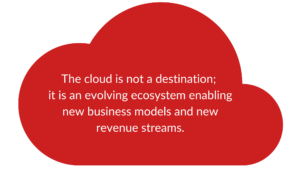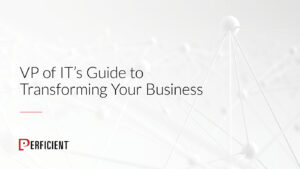As IT leaders and VPs of IT, navigating the challenges of digital transformation can be a daunting task. Balancing the need for innovation and growth with the need for stability and cost-effectiveness is a constant struggle. However, cloud technology offers a way to achieve both goals through the implementation of a comprehensive Cloud Transformation strategy. In this series of blog posts, we will explore the four pillars of a successful Cloud Transformation: Program Model, Cloud Foundations, Portfolio Transformation, and Enterprise App Migration. In this first installment, we will specifically focus on the importance of a Program Model and the key elements that should be considered to ensure a successful implementation.
Unlocking the Potential of Cloud Transformation
Economic headwinds, geopolitical and supply chain disruptions, a shortage of experienced talent, and a “cloud spend reckoning” are driving organizations to take a “Do More with Less” approach – and cloud technology is the key to meeting these parallel goals.
Cloud platforms provide a solution to this uncertainty. Through maximizing digital capabilities while working within IT and organizational constraints, cloud technology can:
- Reduce management complexity
- Provide a tangible ROI
- Improve business resiliency
- Align IT investments with evolving business priorities
Cloud technology not only addresses uncertainty, but also allows organizations to recapture value and invest it back into improving the business. It transforms IT from a cost center to a value-adding contributor to the company’s mission, thanks to its inherently innovative nature, which provides the foundation for new digital workloads.
The cloud is not a destination; it is an evolving ecosystem enabling new business models and new revenue streams.
Most organizations are embracing multicloud strategies, and many will maintain a form of hybrid cloud to respect existing investments and address data sensitivity and compliance concerns. Nearly half are taking a cloud-native-first approach, and nearly all continue to modernize to meet operational agility and business capability demands. (Forrester) Even in difficult times, transformation is here to stay.
Essentials of Cloud Transformation Planning
To ensure a successful cloud strategy and avoid risks, rework, and unnecessary spending, it’s important to be aware of key “Get Right” concepts as a baseline for modernization.
- Stakeholder Buy-in: It’s critically important to have support of executive leaders for investments in resource allocation, vendor commitments, tooling, partner engagement, program prioritization, change management, process modernization, financial management, and organizational awareness. These leaders should also act as high-level champions for the program effort. Without buy-in from stakeholders, it can be difficult to secure funding and resources for your cloud transformation program, and to gain support for the changes you wish to make.
- Business Objective Alignment: To avoid knowledge silos and shadow IT risks, it’s important to align cloud strategy and technical direction with organizational vision. This includes factors such as vendor relationships, existing investments, portability requirements, go-to-market strategies, geographic footprint, cloud-first vision, build vs. buy tendencies, and seamless alignment with enterprise architecture, cybersecurity, and operational mandates. Collaboration here is no small task, but critical to future-proofing your transformation. By involving key stakeholders from different departments in the cloud strategy planning process, the company can ensure that the chosen vendor relationships, existing investments, portability requirements, and go-to-market strategies align with the overall organizational vision. This prevents the creation of knowledge silos and reduces the risk of shadow IT, as all departments are aware of and invested in the chosen cloud strategy.
- Program Framework: Define a structured cloud program with dedicated resources to plan and execute cloud modernization and enable downstream teams. Program leadership and partner peering are key to sustainable progress: define a communication cadence, invest in program management, actively collaborate with partners, and groom a program backlog. Provide consistent reporting to all stakeholders to build trust in the investment and adapt program priorities as needed, as business objectives will certainly change over time. By creating a structured cloud program with dedicated resources and clear leadership, the organization can effectively plan and execute cloud modernization efforts. This includes establishing a communication plan with key partners and stakeholders, investing in program management, and creating a backlog of tasks and priorities to guide the program’s progress. Additionally, by providing consistent reporting to stakeholders, the organization can build trust in the investment and adapt program priorities as needed to align with changing business objectives.”
Building Blocks for a Strong Cloud Strategy
In addition to these key concepts, it’s crucial to have a solid Cloud Strategy in place. A well-defined Cloud Strategy includes several important elements such as:
- Governance: Effective governance establishes policies and guardrails to ensure secure, compliant deployments and enforces proper naming, tagging, and cost control behaviors across an entire control plane while enabling productive, self-directed teams. A dedicated governance committee or team can oversee this process and ensure policies remain relevant and effective.
- Technology Direction: Having a clear technology direction and vision is essential for successful cloud adoption. This includes deciding which public and private clouds are relevant for the organization and the reasons why, as well as defining the core infrastructure and connectivity model. Additionally, providing guidance on application frameworks and target platforms, such as containers vs PaaS services, cloud-native vs 3rd party, database, storage, and HA/DR requirements, can help teams make informed decisions and ensure consistency across the organization.
- FinOps: This is a collaborative process that focuses on optimize investments, maximizing business value and identifying wasteful spending. It often involves cost management tools to gain visibility for consumption and making proactive recommendations for deployed resources.
- ESG / Sustainability: A strategic framework for identifying, assessing, and addressing organizational objectives and activities around environmental, social, governance, and sustainability. Cloud adoption can be a very powerful driver toward desired ESG outcomes.
- Data: Ensuring that data strategy and workload modernization align to create a scalable data foundation for improved analytics, AI, and ML capabilities.
- Integration and Interoperability: A strategy for secure and governed connectivity between systems and environments, including the use of APIs, APIMs, and data pipelines. This allows for seamless communication and data exchange, and an extensible architecture for future expansion and innovation.
- Automation: Implementing automation practices throughout the deployment process to streamline operation, reduce deployment complexity, improve business resiliency, and allow for faster feature delivery.
- Operations: A comprehensive approach to effectively monitor, manage, and optimize workloads and environments across hybrid and multicloud scenarios. This includes the use of cost management tooling and cloud resource management tools and services, both cloud-native and agnostic third-party tools, as well as potentially utilizing managed services from partners to ensure optimal performance and cost efficiency.
Next Steps
Achieving right these “Get Rights” of cloud transformation is not a simple task and requires knowledge of an organization’s skillsets, culture, and appetite for change. Understand that strategy and planning are worthy investments for long-term success. Work with a trusted and empathetic partner that understands the IT team may be learning as they go – and will provide peering and skills guidance to ensure a successful cloud transformation experience for continued organizational success.
The next blog in our series will focus on Cloud Foundations and provide further insights on how to achieve success in this area. Be sure to check it out.
For more in-depth solutions for IT leaders, we highly recommend checking out our free guide called the “VP of IT’s Guide to Transforming Your Business.” This guide provides further insights on how to achieve success in cloud strategy, data, DevOps, and product development to set your organization up for continued growth and success.

